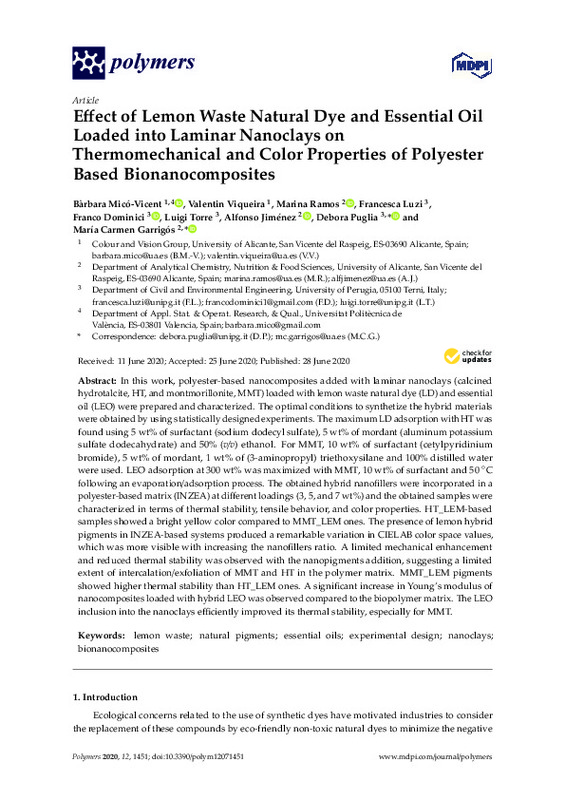JavaScript is disabled for your browser. Some features of this site may not work without it.
Buscar en RiuNet
Listar
Mi cuenta
Estadísticas
Ayuda RiuNet
Admin. UPV
Effect of Lemon Waste Natural Dye and Essential Oil Loaded into Laminar Nanoclays on Thermomechanical and Color Properties of Polyester Based Bionanocomposites
Mostrar el registro sencillo del ítem
Ficheros en el ítem
| dc.contributor.author | Micó-Vicent, B.
|
es_ES |
| dc.contributor.author | Viqueira, Valentin
|
es_ES |
| dc.contributor.author | Ramos, Marina
|
es_ES |
| dc.contributor.author | Luzi, Francesca
|
es_ES |
| dc.contributor.author | Dominici, Franco
|
es_ES |
| dc.contributor.author | Torre, Luigi
|
es_ES |
| dc.contributor.author | Jiménez, Alfonso
|
es_ES |
| dc.contributor.author | Puglia, Debora
|
es_ES |
| dc.contributor.author | Garrigós, Maria Carmen
|
es_ES |
| dc.date.accessioned | 2021-11-05T14:08:02Z | |
| dc.date.available | 2021-11-05T14:08:02Z | |
| dc.date.issued | 2020-07 | es_ES |
| dc.identifier.uri | http://hdl.handle.net/10251/176312 | |
| dc.description.abstract | [EN] In this work, polyester-based nanocomposites added with laminar nanoclays (calcined hydrotalcite, HT, and montmorillonite, MMT) loaded with lemon waste natural dye (LD) and essential oil (LEO) were prepared and characterized. The optimal conditions to synthetize the hybrid materials were obtained by using statistically designed experiments. The maximum LD adsorption with HT was found using 5 wt% of surfactant (sodium dodecyl sulfate), 5 wt% of mordant (aluminum potassium sulfate dodecahydrate) and 50% (v/v) ethanol. For MMT, 10 wt% of surfactant (cetylpyridinium bromide), 5 wt% of mordant, 1 wt% of (3-aminopropyl) triethoxysilane and 100% distilled water were used. LEO adsorption at 300 wt% was maximized with MMT, 10 wt% of surfactant and 50 degrees C following an evaporation/adsorption process. The obtained hybrid nanofillers were incorporated in a polyester-based matrix (INZEA) at different loadings (3, 5, and 7 wt%) and the obtained samples were characterized in terms of thermal stability, tensile behavior, and color properties. HT_LEM-based samples showed a bright yellow color compared to MMT_LEM ones. The presence of lemon hybrid pigments in INZEA-based systems produced a remarkable variation in CIELAB color space values, which was more visible with increasing the nanofillers ratio. A limited mechanical enhancement and reduced thermal stability was observed with the nanopigments addition, suggesting a limited extent of intercalation/exfoliation of MMT and HT in the polymer matrix. MMT_LEM pigments showed higher thermal stability than HT_LEM ones. A significant increase in Young's modulus of nanocomposites loaded with hybrid LEO was observed compared to the biopolymer matrix. The LEO inclusion into the nanoclays efficiently improved its thermal stability, especially for MMT. | es_ES |
| dc.description.sponsorship | The authors express their gratitude to the Bio Based Industries Consortium and European Commission for the financial support to the project BARBARA: Biopolymers with advanced functionalities for building and automotive parts processed through additive manufacturing. This project has received funding from the Bio Based Industries Joint Undertaking under the European Union's Horizon 2020 research and innovation programme under grant agreement No 745578. | es_ES |
| dc.language | Inglés | es_ES |
| dc.publisher | MDPI AG | es_ES |
| dc.relation.ispartof | Polymers | es_ES |
| dc.rights | Reconocimiento (by) | es_ES |
| dc.subject | Lemon waste | es_ES |
| dc.subject | Natural pigments | es_ES |
| dc.subject | Essential oils | es_ES |
| dc.subject | Experimental design | es_ES |
| dc.subject | Nanoclays | es_ES |
| dc.subject | Bionanocomposites | es_ES |
| dc.subject.classification | EXPRESION GRAFICA EN LA INGENIERIA | es_ES |
| dc.title | Effect of Lemon Waste Natural Dye and Essential Oil Loaded into Laminar Nanoclays on Thermomechanical and Color Properties of Polyester Based Bionanocomposites | es_ES |
| dc.type | Artículo | es_ES |
| dc.identifier.doi | 10.3390/polym12071451 | es_ES |
| dc.relation.projectID | info:eu-repo/grantAgreement/EC/H2020/745578/EU/Biopolymers with advanced functionalities for building and automotive parts processed through additive manufacturing/ | es_ES |
| dc.rights.accessRights | Abierto | es_ES |
| dc.contributor.affiliation | Universitat Politècnica de València. Departamento de Ingeniería Gráfica - Departament d'Enginyeria Gràfica | es_ES |
| dc.description.bibliographicCitation | Micó-Vicent, B.; Viqueira, V.; Ramos, M.; Luzi, F.; Dominici, F.; Torre, L.; Jiménez, A.... (2020). Effect of Lemon Waste Natural Dye and Essential Oil Loaded into Laminar Nanoclays on Thermomechanical and Color Properties of Polyester Based Bionanocomposites. Polymers. 12(7):1-22. https://doi.org/10.3390/polym12071451 | es_ES |
| dc.description.accrualMethod | S | es_ES |
| dc.relation.publisherversion | https://doi.org/10.3390/polym12071451 | es_ES |
| dc.description.upvformatpinicio | 1 | es_ES |
| dc.description.upvformatpfin | 22 | es_ES |
| dc.type.version | info:eu-repo/semantics/publishedVersion | es_ES |
| dc.description.volume | 12 | es_ES |
| dc.description.issue | 7 | es_ES |
| dc.identifier.eissn | 2073-4360 | es_ES |
| dc.identifier.pmid | 32605286 | es_ES |
| dc.identifier.pmcid | PMC7407885 | es_ES |
| dc.relation.pasarela | S\424181 | es_ES |
| dc.contributor.funder | European Commission | es_ES |








